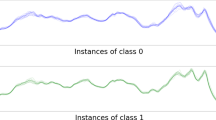Abstract
Big time series data are generated daily by various application domains such as environment monitoring, internet of things, health care, industry and science. Mining this massive data is a very challenging task because conventional data mining algorithms are unable to scale effectively with massive time series data. Moreover, applying a global classification approach to a highly similar and noisy data will hinder the classification performance. Therefore, utilizing constrained subsequence patterns in data mining applications increases the efficiency, accuracy, and could provide useful insight into the data.
To address the above mentioned limitations, we propose an efficient subsequence processing technique with preferences constraints. Then, we introduce a sub-patterns analysis for time series data. The sub-pattern analysis objective is to maximize the interclass separability using a localization approach. Furthermore, we make use of the deviation from a correlation constraint as an objective to minimize in our problem, and we include users preferences as an objective to maximize in proportion to users’ preferred time intervals. We experimentally validate the efficiency and effectiveness of our proposed algorithm using real data to demonstrate its superiority and efficiency when compared to recently proposed correlation-based subsequence search algorithms.
Access this chapter
Tax calculation will be finalised at checkout
Purchases are for personal use only
Similar content being viewed by others
References
Al-Maskari, S., Bélisle, E., Li, X., Le Digabel, S., Nawahda, A., Zhong, J.: Classification with quantification for air quality monitoring. In: Bailey, J., Khan, L., Washio, T., Dobbie, G., Huang, J.Z., Wang, R. (eds.) PAKDD 2016. LNCS (LNAI), vol. 9651, pp. 578–590. Springer, Cham (2016). https://doi.org/10.1007/978-3-319-31753-3_46
Al-Maskari, S., Guo, W., Zhao, X.: Biologically inspired pattern recognition for e-nose sensors. In: Li, J., Li, X., Wang, S., Li, J., Sheng, Q.Z. (eds.) ADMA 2016. LNCS, vol. 10086, pp. 142–155. Springer International Publishing, Cham (2016). https://doi.org/10.1007/978-3-319-49586-6_10
Al-Maskari, S., Ibrahim, I.A., Li, X., Abusham, E., Almars, A.: Feature extraction for smart sensing using multi-perspectives transformation. In: Wang, J., Cong, G., Chen, J., Qi, J. (eds.) ADC 2018. LNCS, vol. 10837, pp. 236–248. Springer, Cham (2018). https://doi.org/10.1007/978-3-319-92013-9_19
Al-Maskari, S., Li, X., Liu, Q.: An effective approach to handling noise and drift in electronic noses. In: Wang, H., Sharaf, M.A. (eds.) ADC 2014. LNCS, vol. 8506, pp. 223–230. Springer, Cham (2014). https://doi.org/10.1007/978-3-319-08608-8_21
Fu, T.C.: A review on time series data mining. Eng. Appl. Artif. Intell. 24(1), 164–181 (2011)
Gavrilov, M., Anguelov, D., Indyk, P., Motwani, R.: Mining the stock market (extended abstract): which measure is best? In: Proceedings of the Sixth ACM SIGKDD International Conference on Knowledge Discovery and Data Mining, 20–23 August 2000, Boston, MA, USA, pp. 487–496 (2000)
Ghazavi, S.N., Liao, T.W.: Medical data mining by fuzzy modeling with selected features. Artif. Intell. Med. 43(3), 195–206 (2008)
Ibrahim, I.A., Albarrak, A.M., Li, X.: Constrained recommendations for query visualizations. Knowl. Inf. Syst. 51(2), 499–529 (2017)
Keogh, E.J., Kasetty, S.: On the need for time series data mining benchmarks: a survey and empirical demonstration. Data Min. Knowl. Discov. 7(4), 349–371 (2003)
Li, Y., U, L.H., Yiu, M.L., Gong, Z.: Discovering longest-lasting correlation in sequence databases. PVLDB 6(14), 1666–1677 (2013)
Mueen, A., Hamooni, H., Estrada, T.: Time series join on subsequence correlation. In: 2014 IEEE International Conference on Data Mining, ICDM 2014, 14–17 December 2014, Shenzhen, China, pp. 450–459 (2014)
Mueen, A., Nath, S., Liu, J.: Fast approximate correlation for massive time-series data. In: Proceedings of the ACM SIGMOD International Conference on Management of Data, SIGMOD 2010, 6–10 June 2010, Indianapolis, Indiana, USA, pp. 171–182 (2010)
Raghupathi, W., Raghupathi, V.: Big data analytics in healthcare: promise and potential. Health Inf. Sci. Syst. 2(1), 1 (2014)
Rakthanmanon, T., et al.: Searching and mining trillions of time series subsequences under dynamic time warping. In: The 18th ACM SIGKDD International Conference on Knowledge Discovery and Data Mining, KDD 2012, 12–16 August 2012, Beijing, China, pp. 262–270 (2012)
Sakurai, Y., Papadimitriou, S., Faloutsos, C.: BRAID: stream mining through group lag correlations. In: Proceedings of the ACM SIGMOD International Conference on Management of Data, 14–16 June 2005, Baltimore, Maryland, USA, pp. 599–610 (2005)
Utomo, C., Li, X., Wang, S.: Classification based on compressive multivariate time series. In: Cheema, M.A., Zhang, W., Chang, L. (eds.) ADC 2016. LNCS, vol. 9877, pp. 204–214. Springer, Cham (2016). https://doi.org/10.1007/978-3-319-46922-5_16
Nahar, V., Al-Maskari, S., Li, X., Pang, C.: Semi-supervised learning for cyberbullying detection in social networks. In: Wang, H., Sharaf, M.A. (eds.) ADC 2014. LNCS, vol. 8506, pp. 160–171. Springer, Cham (2014). https://doi.org/10.1007/978-3-319-08608-8_14
Zhu, Y., Shasha, D.: Statstream: statistical monitoring of thousands of data streams in real time. In: Proceedings of 28th International Conference on Very Large Data Bases, VLDB 2002, 20–23 August 2002, Hong Kong, China, pp. 358–369 (2002)
Acknowledgments
We would like to thank Lemma solutions (www.lemma.com.au) for their help during the production of this paper.
Author information
Authors and Affiliations
Corresponding author
Editor information
Editors and Affiliations
Rights and permissions
Copyright information
© 2018 Springer Nature Switzerland AG
About this paper
Cite this paper
Albarrak, A., Al-Maskari, S., Ibrahim, I.A., Almars, A.M. (2018). Efficiently Mining Constrained Subsequence Patterns. In: Gan, G., Li, B., Li, X., Wang, S. (eds) Advanced Data Mining and Applications. ADMA 2018. Lecture Notes in Computer Science(), vol 11323. Springer, Cham. https://doi.org/10.1007/978-3-030-05090-0_1
Download citation
DOI: https://doi.org/10.1007/978-3-030-05090-0_1
Published:
Publisher Name: Springer, Cham
Print ISBN: 978-3-030-05089-4
Online ISBN: 978-3-030-05090-0
eBook Packages: Computer ScienceComputer Science (R0)




